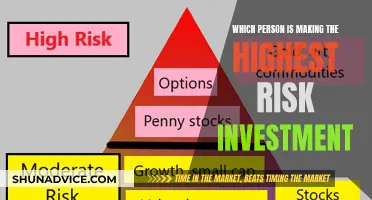
Holding cash in an investment portfolio is a strategy that offers both advantages and considerations. While cash holdings are often criticised for reducing performance in up-trending markets, they can provide liquidity and opportunities for aggressive investors to make opportunistic purchases. Additionally, cash holdings can serve as a hedge against market volatility and provide peace of mind during uncertain economic times. In this article, we will explore the reasons why adding cash to an investment portfolio can be beneficial, the different ways to utilise cash in a portfolio, and the recommended allocation of cash for effective portfolio management.
| Characteristics | Values |
|---|---|
| Purpose | Take advantage of new investment opportunities, maintain a balanced portfolio, manage unforeseen expenses, and navigate market volatility |
| Liquidity | Provides flexibility to seize time-sensitive opportunities and make opportunistic purchases |
| Opportunity | Allows for dollar-cost averaging, enabling the purchase of more shares when prices are low |
| Reduced Volatility | Acts as an anchor to limit losses during market declines and reduces portfolio volatility |
| Emergency Fund | Covers unexpected expenses and prevents the need to sell stocks or bonds during emergencies |
| Diversification | Helps spread risk and protect against market volatility |
| Market Trends | Staying informed about market trends and news provides insights for making timely investment decisions |
| Financial Goals | Consider life stage, retirement plans, and risk tolerance when determining the amount of cash to hold |
| Peace of Mind | Reduces chances of panic-selling during volatile markets and provides psychological comfort |
| Investment Strategy | Cash facilitates success by enabling the exploitation of opportunities and acquisition of assets at a lower cost |
What You'll Learn

Liquidity and Opportunity
Liquidity
Liquidity is the ability to convert an asset or security into cash quickly, without affecting its market price. It is one of the three most important metrics of any asset, along with profitability and risk. Cash is the most liquid asset, followed by cash equivalents such as money market accounts, certificates of deposit, and marketable securities like stocks and bonds.
The liquidity of an investment is usually dependent on whether the asset can be actively traded on financial markets and the demand for it. For example, common stocks can usually be sold quickly due to high demand on the stock market, whereas real estate often takes longer to sell as it requires finding a reliable buyer, showing the property, etc.
Opportunity
Having cash in your investment portfolio provides liquidity for future investment opportunities and helps maintain a balanced portfolio. It allows you to seize potential investment prospects, navigate market volatility, manage unforeseen expenses, and capitalize on sudden market dips or time-sensitive opportunities.
Additionally, holding cash in your portfolio can act as a hedge against market downturns and reduce portfolio volatility. It provides a stable value that can limit losses during market declines and reduce the impact of high volatility.
Therefore, by adding cash to your investment portfolio, you gain liquidity and the opportunity to make strategic investments, navigate market fluctuations, and reduce risk.
Invest Your Savings: Safe Strategies for Beginners
You may want to see also

Reduced Portfolio Volatility
Holding cash in your investment portfolio can be a strategic move to reduce portfolio volatility. While it may reduce returns in an appreciating market, cash holdings serve as an anchor, limiting losses during market downturns. For instance, a 20% decline in a fully invested portfolio results in a 20% loss. However, by reducing market exposure to 80% and maintaining a 20% cash position, the same market loss results in only a 16% portfolio loss.
The amount of cash held in a portfolio depends on investment objectives and risk tolerance. A cash cushion can provide peace of mind and reduce the likelihood of panic-selling during volatile market conditions. Additionally, access to cash during a downturn may eliminate the need to sell stocks or bonds to cover emergency or unplanned expenses.
Cash holdings also offer liquidity, enabling opportunistic purchases when company valuations become attractive. For example, an investor may utilise dollar-cost averaging, buying more shares when prices are low and fewer when prices are high, thus reducing the average cost per share.
Furthermore, cash reserves help navigate market volatility by providing flexibility to manage unforeseen expenses, capitalise on sudden market dips, and seize time-sensitive opportunities.
To effectively manage cash holdings, investors should regularly monitor their cash balance, ensuring they are prepared to act on potential investment prospects. While cash holdings can reduce portfolio volatility, it is important to note that staying in cash for extended periods may not be advisable due to the erosive effects of inflation.
Young Adults: Best Places to Invest Your Savings
You may want to see also

Cash Investments
One of the key advantages of holding cash is liquidity, which allows investors to seize opportunistic purchases when company valuations become attractive. Additionally, holding cash can help reduce portfolio volatility by serving as an anchor to limit losses during market declines.
While cash investments offer safety and liquidity, they may not be ideal for long-term goals due to their low returns. They are more suitable for retirees and investors with short-term spending needs. It is recommended to balance your cash and investments, as holding too much cash can hinder your ability to meet long-term financial objectives.
Where to Find National Savings and Investments
You may want to see also

Emergency Funds
A good rule of thumb is to save enough to cover your necessary expenses for three to six months. This ensures you have a buffer during financial setbacks, such as unemployment or reduced income. However, the specific amount depends on your personal situation; if your income is stable, a smaller fund may suffice, while a less stable income may require savings for up to a year.
Where Should You Keep Your Emergency Funds?
It is recommended to keep your emergency funds in a separate account from your long-term investments. This ensures that your emergency funds remain easily accessible and don't interfere with your investment goals. Here are some options for where to keep your emergency funds:
- Savings Account: This is a safe option for your emergency funds as it is FDIC-insured up to $250,000 per depositor, per bank. While the interest rates are generally low, your money will be readily available without any penalties or delays.
- Money Market Account: These accounts offer higher interest rates than traditional savings accounts and are also FDIC-insured. Some money market accounts provide debit cards or check-writing privileges, giving you instant access to your funds.
- Certificate of Deposit (CD): CDs can offer higher interest rates, especially with longer maturities. However, withdrawing money before maturity usually incurs an early withdrawal fee, reducing the accessibility of your funds.
What Not to Do with Your Emergency Funds
It is generally not advisable to invest your emergency funds in the stock market or other high-risk investments. Doing so may expose you to potential losses, and you may be forced to sell at a loss during an emergency. Additionally, avoid keeping your emergency funds in physical cash at home, as this provides poor returns and carries a risk of theft.
Savings Transform to Investment: When and How?
You may want to see also

Diversification
There are different ways to diversify your portfolio:
At a high level, investment instruments can be classified into three main asset classes: fixed income, equity, and gold.
- Fixed income or debt is the lowest-risk asset class, which includes risk-free assets like bank fixed deposits and government savings schemes. These risk-free assets also tend to offer the lowest returns.
- Gold is a step up from fixed income in terms of risk and has the potential for higher returns over the long term.
- Equity carries the highest risk among the three asset classes but also offers the highest returns over sufficiently long investment periods.
Different asset classes perform differently in various economic cycles. For instance, fixed income outperforms equity in bear markets, while equity shines in bull markets. By diversifying across these asset classes, you can smoothen the volatility of your portfolio and aim for good returns in the long term.
Risk Diversification in Equity
Equity investments come with two types of risk: systematic or market risk, which is caused by events affecting the entire economy, and unsystematic risk, which is specific to a company or industry sector. Unsystematic risk can be mitigated by investing in a portfolio of stocks from different companies. Mutual funds are an excellent tool for diversifying this type of risk.
Risk Diversification in Fixed Income
The main risk factors in fixed-income investments are interest rate risk and credit risk. Diversifying your fixed-income portfolio based on your investment needs, such as liquidity, investment tenure, and risk appetite, can help manage these risks. A mix of different duration profiles, from short-term to long-term instruments, can cater to various liquidity, risk, and return objectives.
Mutual funds offer an accessible way to diversify your portfolio, as they pool money from multiple investors to invest in different securities. They can provide diversification across company concentration risk and sector risks by investing in multiple industry sectors and market capitalizations. Additionally, hybrid funds offered by mutual funds allow exposure to both equity and fixed-income asset classes.
Beyond stocks and bonds, alternative investments like real estate investment trusts, hedge funds, art, and precious metals provide further diversification opportunities. These investments can help you access different markets and reduce the correlation with traditional financial markets.
However, it's important to remember that over-diversification can dilute your returns. The optimal number of stocks for a diversified portfolio is generally considered to be around 20, allowing for a balance between risk reduction and meaningful investment impact.
Emergency Savings: Invest or Keep?
You may want to see also
Frequently asked questions
Log in to your Google Finance account and locate the "Cash" section on your portfolio dashboard. Click on the "Add Cash" button, enter the amount, select your payment method, verify the transaction, and confirm the deposit.
Adding cash to your portfolio increases liquidity, allowing you to seize new investment opportunities and providing flexibility during market volatility. It also helps to reduce portfolio volatility by serving as an anchor to limit losses during market declines.
The amount of cash to keep in your portfolio depends on your investment objectives, risk tolerance, and life stage. Generally, it's recommended to have at least 5% in cash, while some investors prefer 10%-20% or even higher. Ensure you have sufficient emergency funds, typically covering 6-12 months' worth of living expenses.
Alternative methods include linking your bank account to enable direct transfers, setting up automatic deposits for consistent contributions, or using third-party payment services like PayPal or Venmo for added flexibility.







